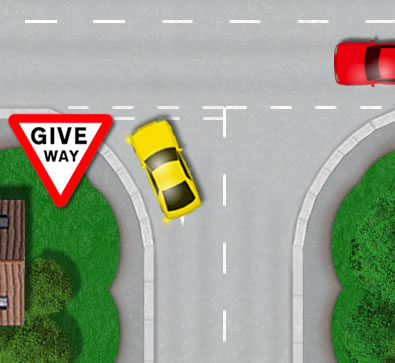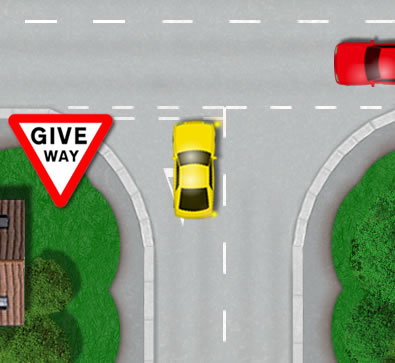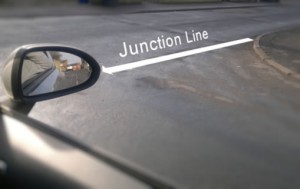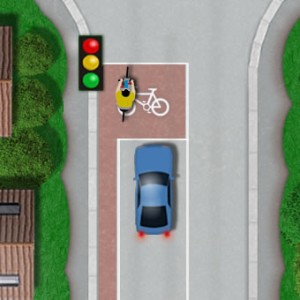Junction lines are in place for drivers to give way or stop for traffic that is crossing. It can be difficult for learner drivers to know exactly where a junction line is in terms of stopping in the correct position.
Learner driver actions around junctions and junction lines fail many driving tests. In fact, junctions are the number one test failure based on official statistics.
Stopping too soon before a junction line can be dangerous because any vehicles behind will not be expecting you to stop so early.
Stopping too late, on or over a junction line is also dangerous as it may force drivers on the road you intend to enter to take evasive action to avoid hitting you. This tutorial offers a simple guide and remedy for learner drivers to understand the correct position to stop at a junction line.
Correct position for stopping at a junction line
Whilst learning to drive and of course during the practical driving test, examiners are very strict with regard to the correct position of your vehicle at junctions.

Correct Position for Turning Left at a Junction
When turning left at a junction, stop so the front of your car is just behind the junction line as the picture suggests. Try not to get too close to the kerb on the left as you may risk driving up the kerb or hitting the wheels on it when making the turn.
The position is important as it will allow you to turn left into the new road, correctly into the lane and not to make a wide turn. If the road is wide enough, it may also allow for vehicles turning right to pull up besides you.

CORRECT POSITION FOR TURNING Right AT A JUNCTION
When turning right at a junction, if the road is wide enough for two cars at the junction line, position your car just to the left of the centre line and just before the junction line. Correct positioning at the junction will allow for easier turning when pulling out and not risk making the turn too wide.
When to stop at a junction
When teaching learner drivers, the best method to use is to establish reference marks / points. A reference mark can be used for knowing where to stop at a particular time. In this case, at a junction line.

In this picture, the car has come to a stop at a T-junction. The picture taken is from what the learner driver will see. The junction line arrow is pointing towards around the centre of the right side mirror. This line is where the junction line is. As you slowly approach a T-junction, you can line the junction line up with this reference mark so the junction line lines up with the centre of your right side mirror.
Your car will likely be a different make and model, so you may need to slightly alter the reference mark to line the junction line up with. It will however be similar. Approach junction slowly using this reference mark. After a short while you will be stopping at the correct position without the need of a reference mark.
Some quiet residential junctions don’t have junction lines. In this case you will need to line the edge of each curb up where the junction line would be if there was one. Make an imaginary junction line to use with your reference mark.
Cycle lanes
Driving test examiners are strict when it comes to dealing with cyclists. When coming to a stop at a junction, ensure you do not stop in the cycle waiting area by stopping just behind the first junction line.

Whilst driving during the test, keep a close eye on cycle lanes. Some cycle lanes have dashed lines which means you can drive in them if necessary, although try to avoid if possible. Others have solid white lines. Avoid driving in cycle lanes with solid white lines. See Cyclists and cycle lanes for further information on dealing with cyclists during a driving test.
Further information related to junctions
Below are various tutorials to help you learn junctions
- Road junctions
- Types of junctions
- Turning left at a junction
- Turning right at a junction
- Box junction
- Staggered junction
- Y Junctions
- D Junctions
- Junction signs
- Emerging from a junction
- Creep and peep

On my part 3 driving instructor training and have found this site very helpful at ensuring I use the correct rules when teaching students…thank you!
That’s great to hear Lesley. Glad you are finding it useful and good luck for passing and becoming a fully qualified driving instructor.
Hi!
How to know when to stop at unmarked junctions and how do you distinguish them?
Hi Sorin,
You know where the line is on marked junctions, at the end of the road? You essentially need to place an imaginary line where the road ends in your mind and use that to stop at. You can use reference point just like the photo at the end of this page using an actual junction line, then using a line that you’re imagining is there at an unmarked junction. Takes a little practice, but it’s not too much trouble to get the hang of. Provided you know where to stop at marked junctions, try assessing where the junction line is at unmarked junctions and keep practicing.
To distinguish them, you first need to know where you are. You’re likely to see unmarked junctions in quiet residential streets or at some junctions on quiet country roads. You may or may not have a sign warning you to give way.
It’s really about appropriate speed and observation. Driving at an appropriate speed that allows you to assess what’s going on ahead is important. You need to be looking ahead for objects that are directly ahead in the horizon and that appear to be ‘blocking’ the road. For example of a hedgerow is what you can see going across the road up ahead, that’s a good signal that there’s a junction there, or at least a sharp corner. This could also be parked cars, houses, fences etc. As you get closer, you should begin to see the end of your road and the new road ahead.
As I said, speed is critical because as you get closer, you’ll need to give yourself time to acknowledge that it is a junction and time to safely deal with it. It’s always safest to be a little too slow than too fast because you don’t always know with what you’re dealing with until you’re pretty much there.
Hi
Just wondering if you can give a bit of clarification around junctions. A vehicle was at the right of a junction, so my son pulled into the left of the junction due to him turning left. When the vehicle at the right moved forward it, hit my sons stationery car. My sons insurance is saying that because there was no line he should not have gone alongside the vehicle turning right. I have been driving a long time and I do it and see it happening all of the time. Do you know if the insurance is correct. Many thanks.
Hi Angela,
So there’s a T-junction and turning right out of the T-junction is a car that’s already in position, then your son comes alongside the right-turning car to turn left? There’s no law that states that you must only pull alongside another vehicle only if there are lane dividers.
However, the right-turning car already had position in the road, so it could be argued that there wasn’t sufficient space for your son to pull alongside the other vehicle. I’m not sure how the other vehicle hit your son’s car, but I think the insurance company are referencing the lane line due to the fact that as there wasn’t a dividing lane line, it was essentially a single lane and therefore the car turning right had priority to manoeuvre within the lane.